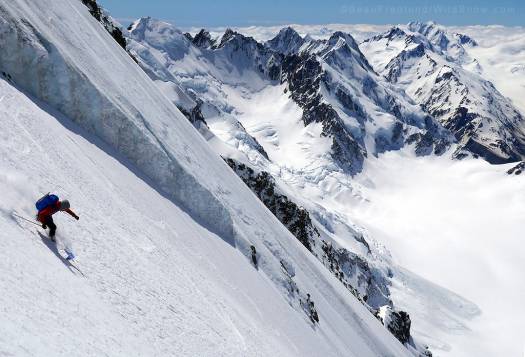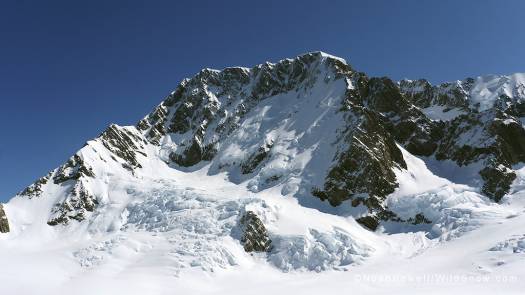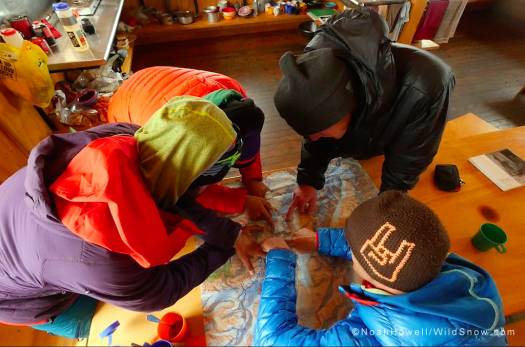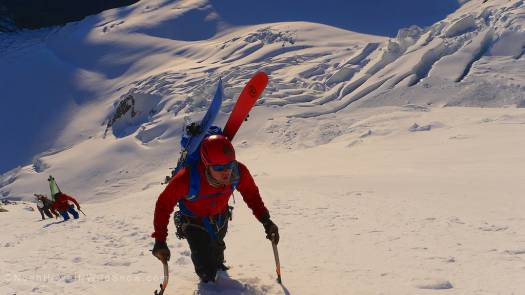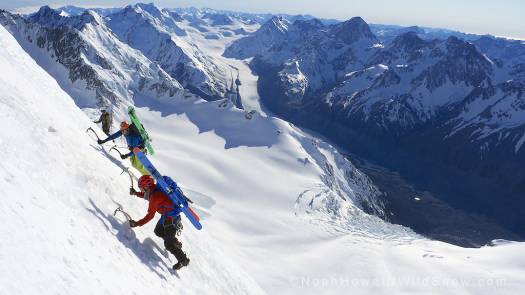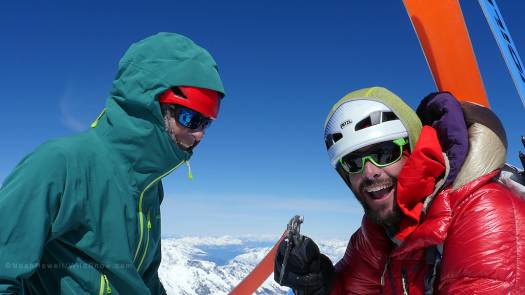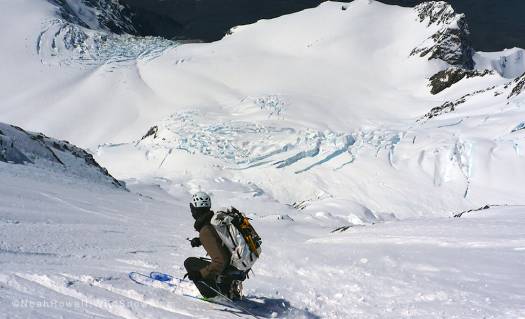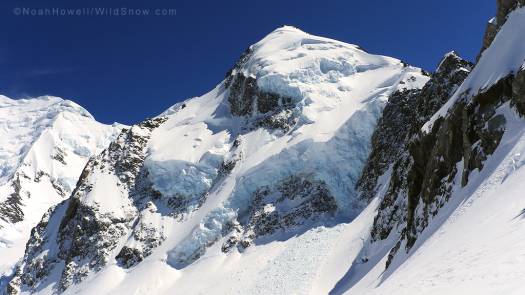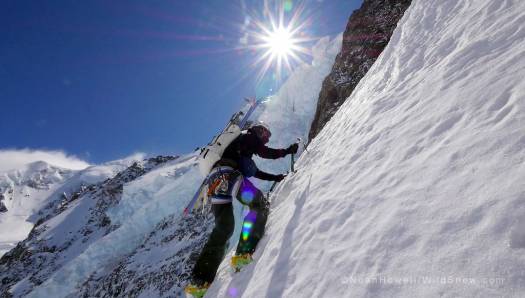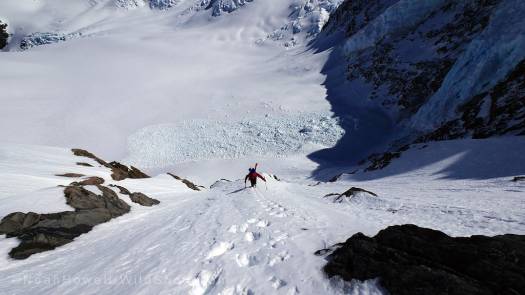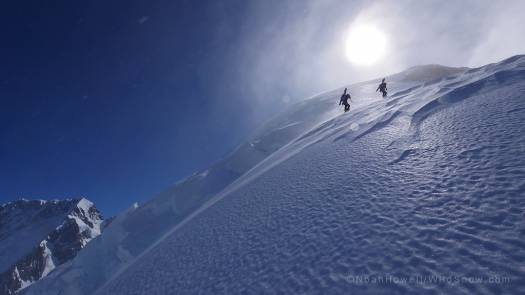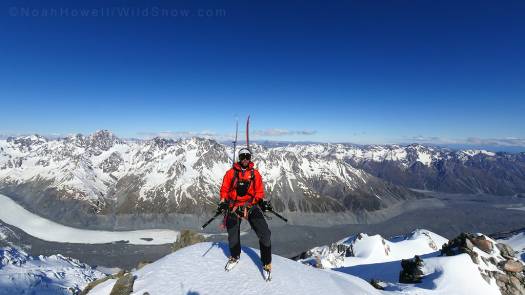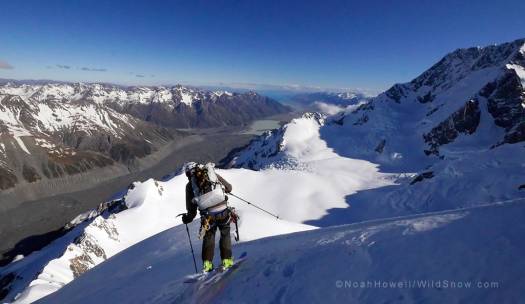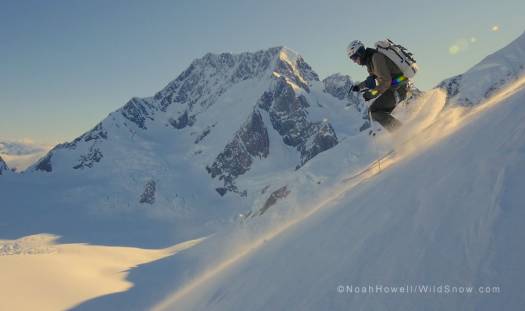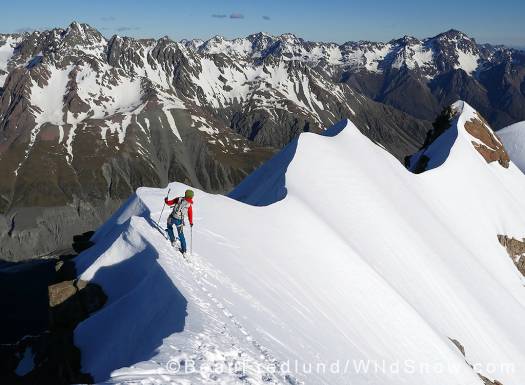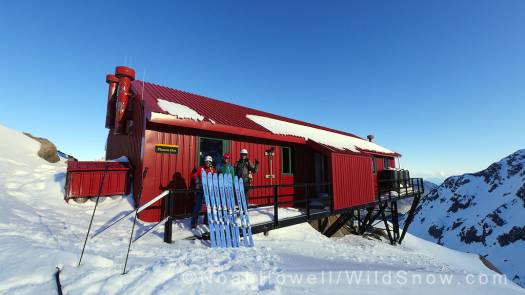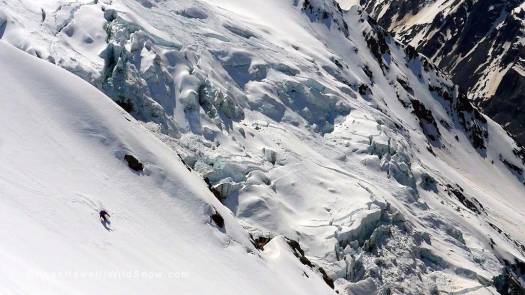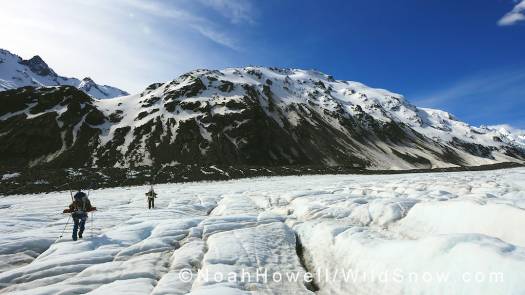With the Rugby World Cup starting this Friday it is time to understand more about the top teams. This is the best article I have ever read about how the All Blacks remain at the pinnacle of rugby. Written by Andy Bull, an English writer for the Guardian. Read on.......
The making of an All Black: how New Zealand sustains its rugby dynasty
A country of just four million is home to arguably the most dominant team in sport. But how do the All Blacks remain at the pinnacle more than 100 years after the ‘Originals’ established their supremacy?
 The All Blacks perform the haka before their match with Ireland at Eden Park in June 2012. Photograph: Phil Walter/Getty
A death in the family’
The All Blacks perform the haka before their match with Ireland at Eden Park in June 2012. Photograph: Phil Walter/Getty
A death in the family’
His full title is Sir Graham Henry, but everyone calls him Ted. Even people who hardly know him. It’s a nickname he was given as a kid when he used to work the scoreboard at his local cricket club.
And at Eden Park, decades later, it opens all doors. At 10am on a Wednesday morning, the Auckland stadium, the largest in New Zealand, is almost deserted. Except for me, my photographer and a security guard.
“Can I help you?”
“Can you let us in?”
“We’re shut.”
“We’re here to meet Sir Graham Henry.”
“Ted? You should have said. Come on in.”
It was here, in October 2011, that Henry’s All Blacks beat France 8-7 in the World Cup final. He was knighted soon afterwards for services to the game and, you suspect, services to his nation. New Zealand had not won a World Cup since 1987, that barren streak all the more extraordinary given they have always been so good. In 112 years of playing rugby, New Zealand’s winning percentage is 78. In 20 years since the sport turned professional, that figure has risen to 84. As world champions, the All Blacks have become even better.
In 2013 an English journalist wandered into New Zealand’s team room and saw the phrase “we are the most dominant team in the history of the world” written on a whiteboard. It’s not far wrong. In the four years since the last World Cup, the All Blacks’ winning percentage has risen to 93. Count the defeats on one hand and you will have two digits spare. In the same period there have twice been two new moons in the space of a single month. The All Blacks really do lose once in a blue moon.
Advertisement
Henry arrives at Eden Park. His sense of humour is so dry that if you rubbed two of his jokes together they would catch light. Foxed by jetlag, I find it impossible to tell when he is joking. First question is an ice-breaker.
“So how do you think the All Blacks will go in the World Cup?”
“Aww,” Henry replies, “I think they’ll be competitive.”
The only giveaway is how he cocks his left eyebrow.
I explain that I’m in New Zealand working on an article about “why the All Blacks always win”.
“We don’t,” Henry says. This time the eyebrow stays down.
Henry was head coach of the All Blacks between 2003 and 2011. In that time they played 103 games and won 88 of them. He remembers the defeats more clearly than most of the victories. He is surprised an Englishman could feel in thrall to New Zealand given that England won the previous two editions of the World Under-20 Championship, in 2013 and 2014 (New Zealand won this year’s, beating England in the final)
93%
In the four years
since the
2011 World Cup
87%
Since Graham Henry
took charge
post 2003 World Cup
84%
Since Professionalism
(1995)
World Cup matches
Wins in 1987 and 2011
.
This reminds me of something one of his predecessors, John Hart, said in an interview with the academic Tom Johnson in the book Legends in Black. “We don’t understand how good we are, how great we are in this game of rugby … We’ve won, historically, about 75% of our games, which is huge in the international sporting arena – yet we lose a couple of Tests and all of a sudden the world has come to an end.”
Advertisement
I remind Henry that England have beaten New Zealand only seven times in 40 matches and once in the last 12 years. Wales have beaten them three times, the last in 1953; Ireland and Scotland have never beaten them at all. He nods. Put like that, the question makes more sense.
Henry thinks about it. “You have to understand, New Zealand is a very young country and rugby has put this country on the map. This country earned respect from the rest of the world for three things: what we did in two world wars, and to a lesser extent what we’ve done on the rugby field. So over time rugby has become a major part of our national identity. And the current All Black team, the All Black teams of recent years, have always tried to add to that legacy, that history.”
To understand New Zealand’s game today you have to understand how it began. In particular, the 1905 tour to Europe and the USA or the “Originals”, as they are now known. They played 35 matches and won 34, scored 976 points and conceded 59.
Jock Phillips is perhaps New Zealand’s most respected historian. After speaking to Henry, I catch him on the phone. “Rugby really took off as a national game at the turn of the century,” Phillips says, “and the crucial thing there was the 1905 All Black team. The context of that was that New Zealand had always – has always – had a certain insecurity about its place in the world. We’ve always got a certain anxiety that we are falling off the edge, that we don’t really count.” The tour, he says, “gave New Zealanders a sense that they had a role to play in the empire”.
We’ve always got a certain anxiety that we are falling off the edge, that we don’t really count.
In 1905, the prime minister, Richard Seddon, arranged to have reports of the tour matches sent back to New Zealand through the telegraph installed in his offices and distributed around the country. Seddon was one of around 20,000 people waiting at Auckland harbour when the team finally made it home. As a report in the Auckland Observer put it, the tour “advertised the country in a way that a score of immigrant agents and half-a-dozen Tourist Departments could not have done”.
Distant history, but the tour still resonates today. Almost a century later, the prize-winning author Lloyd Jones wrote a novel about it, The Book of Fame. In it, Jones tracks the burgeoning celebrity of the team by counting up the lines they were awarded in the Times and other British newspapers.
“Versus Devonport Albion – 50 lines, 40 lines more than given to ‘Mr Roosevelt on Lynch Laws’. Versus Midland Counties – 72 lines! in the Times … plus 92 lines on ‘The Revolution in Rugby Football’. More than ‘bloodshed in Odessa’, ‘Russian Warship Mutiny’, ‘The Conflict in Hungary’ and ‘Lord Roseberry’s address on Scottish history’ combined.”
The legacy was embellished by the 1924-25 “Invincibles” tour to Britain, when the team were unbeaten in 32 matches. Perfection became the All Black standard. Colin Meads, who played 55 Tests and was chosen as New Zealand’s player of the century in 1999, put it to Tom Johnson like this: “When we lost in our days it was a national tragedy, a national disaster, and you got, not abused, but scorned by people.” And so, according to Meads, the All Blacks were motivated by fear. But “it is not a fear of losing; it’s a fear of letting your country down”.
Henry once said that every All Black defeat felt like “losing a member of the family”. He was criticised for it. “When I said that, that defeat was like a death in the family, what I really meant was that’s how strongly committed we were to trying to win.”
Crowds flock to watch Auckland grammar, which lists Grant Fox, Doug Howlett and Sir Edmund Hillary among its former pupils. Facebook Twitter Pinterest
Crowds flock to watch Auckland grammar, which lists Grant Fox, Doug Howlett and Sir Edmund Hillary among its former pupils. Photograph: Auckland grammar
‘Per Angusta Ad Augusta’
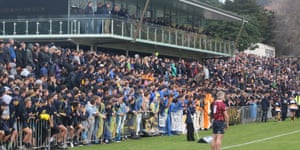
Next day, I call John Daniell. A friend had put us in touch. Daniell was born in New Zealand and educated in England. After university he spent a decade playing professionally in France. These days he is a writer. His autobiography won awards and he has just finished his first novel. “I’ll meet you in the lobby,” he tells me. “I’ll be the tall one.” And so he is. Six-foot something staggering.
Daniell is an affable man, intelligent, with a thick French streak in his soul. He likes to live well. We drink far too much wine and my notes from the evening do not amount to much. A few things stick. Daniell explains that in New Zealand, “catch” and “pass” have almost come to be conflated into one word: “catchpass”. This is the fundamental skill, the first thing learned by kids, and still practised hard by the professionals. Daniell says a conspicuous difference between the teams he played with in Europe and those in New Zealand was the time spent drilling catching and passing.
My mind turns back to the conversation with Henry. We were discussing New Zealand’s famous win against Ireland in 2013, 24-22, sealed with an impossible try in injury time. “That great try,” Henry says. “I don’t know how many passes it took to make it. 25? Catch-pass. Catch-pass. Catch-pass.” If one pass had been misplaced, if one catch had been fumbled, the ball would have gone dead and the game would have been over. A simple skill, perfected.
“So where are you going next?” Daniell asks.
“Auckland grammar.”
“Good idea.” He looks me over. “But you should probably shave before you go. Last time I was there I had a beard and the coach told me I was setting a bad example to his players.”
I laugh.
“No,” he says, “I’m serious.”
Next time I see Henry he is wearing a kipper tie, looking out from the front row of an old photograph hanging in a corridor at Auckland grammar. It was his idea to come here. “The key to New Zealand rugby is the strength of the competitions our young people play,” he said. “Especially in the schools.” Altogether, there have been 1,146 All Blacks. Fifty-one of them studied at Auckland grammar, more than any place else in New Zealand.
In New Zealand, school first XV rugby is a serious business. Sky broadcast the matches live, two every weekend. Here at Auckland grammar they pull in crowds of around 7,000 for marquee games. The standard is excellent, the competition intense. It is becoming increasingly common for players to make the leap from school straight into the professional game.
Auckland grammar was established in 1868. The first game of rugby in New Zealand was played in 1870. It is a state school but receives a lot of money in donations. The sums top schools spend on rugby make many feel uneasy. A 2013 investigation by the New Zealand Herald found that in Auckland the top schools were spending upwards of $50,000 (£21,000) a year on their first XVs and some, those running foreign tours, up to four times that much.
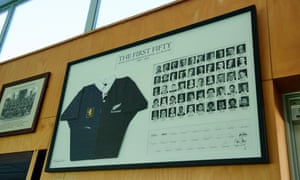
Altogether there have been 1,146 All Blacks and 51 of them have studied Auckland grammar school. Photograph: Scott McAulay for the Guardian
The main building was designed in the style of a Spanish mission, and would look wild west if it were not for the Latin tag – Per Angusta Ad Augusta, “through difficulty to greatness” – etched in bold letters over the porch.
Advertisement
I’ve come, clean-shaven, to meet the school’s director of sport, Grant Hansen. Like all sport staff here he’s not only a coach but a teacher.
Almost nine out of every 10 staff members volunteer to help organise some form of sport, something Hansen picks out as a big reason for the school’s success. They are not paid to coach but the school does sponsor their training.
Hansen leads us on a short tour. We start in the hall of fame, where he picks renowned players out of the photos. There’s Doug Howlett, who became the All Blacks all-time leading try-scorer. There’s Grant Fox, one of the finest fly-halfs in history. There’s Martin Crowe, one of New Zealand’s greatest cricketers and also, in his day, a fine winger, albeit against his will. Henry made him play. All illustrious, but none the most famous alumnus. That would be Sir Edmund Hillary.
“He climbed mountains,” Hansen says. “Never made the first XV, though.”
Extracurricular sport is not compulsory at Auckland grammar but 90% of the kids play it. They have a pool of around 90 competing for spaces in the first XV. By now it is lunchtime and kids are swarming the playing field. In every spare outdoor corner, kids are playing with rugby balls. Kicking them to and fro, playing keep-away or catch. Hansen nods towards one lad we pass. He stops and pulls up his socks. “Sorry, sir.”
In some ways Auckland grammar seems very traditional. Rugby is not played all year-round and they will never pull a boy out of class to come and practise. Quite the opposite. “If a boy is not performing academically,” Hansen says, “he will get pulled from the team.” At the same time, its sports program is surprisingly – astonishingly in my eyes – modern and the facilities are so good that the All Blacks often train here before Test matches at Eden Park.
On the Monday after a match the boys take ice baths in the school’s recovery lounge. They call it the “flush session”. They train on Wednesday and Thursday, practise skills on Friday, and play on Saturday. On top of that, there is a structured weight-training program. There is a nutritionist and they have occasional coaching from men such as Henry, Fox and the All Blacks manager, Darren Shand. The New Zealand Rugby Players Association often comes, too, to talk about welfare and, in particular, how to handle approaches from professional agents.
For all this, the school’s record in recent years is not what it once was. The first XV have been successful and they have produced plenty of professional players for teams around the world – old boys represented six different countries in the last three World Cups – but their only All Black of the last decade was Benson Stanley, who played three matches in 2010.
Hansen smiles. He thinks they will have another soon enough. His name is Rieko Ioane. Three months after he left the school, he was playing for New Zealand’s sevens team. He was only 17. It so happens that Ioane is playing across town the very next day.
0:00
/
0:00
Facebook Twitter Pinterest
The surprising history of the haka: it’s not just the All Blacks’ war dance.
‘A volunteer operation’
Advertisement
Ponsonby was once a run-down neighbourhood, populated largely by Pacific islanders who moved here after the second world war. Then developers came and the demographics changed. A lot of those same families have sold up and moved on. Ponsonby RFC are still here, though, the oldest and most successful rugby club in Auckland. Just like Auckland grammar they are proud of their record of producing All Blacks. They boast 52, putting them equal first among the 520 clubs in the country. Added to that, another 29 men have played Test rugby for Samoa.
Ponsonby play at the Western Springs speedway stadium, their main pitch in the centre of the track, surrounded by steep grass banks on two sides. They run 56 junior and 12 senior teams. This Saturday there are three games on. Two junior matches, though you would never know it from the size of the players. The props must weigh 16 stone apiece. When those matches are over, the players gather around the main pitch to watch the seniors play Pakuranga.
Rieko Ioane is easy to spot. He’s in the centre, moving with speed and power that make him just a little sharper than everyone around him. He scores two tries.
Ioane’s father played for Samoa, his mother for New Zealand, and his elder brother, Akira, is with the Auckland Blues. At Ponsonby, Mum is the junior administrator and Dad helps manage the seniors.
Earlier in the season Ioane was playing for New Zealand sevens in London. He flew home on the Wednesday, trained on the Thursday, played in a crucial match for Ponsonby on the Saturday. And scored three tries.
After the match everyone gathers in the little clubhouse. There is a bar at one end and an astonishing collection of memorabilia at the other. Among it, sacred relics from the 1905 tour. The Originals’ skipper, Dave Gallaher, was a Ponsonby man. Today, France and New Zealand play for the Gallaher Trophy. A 1905 jersey belonging to another player, George Nicholson, is in a glass case. One like it recently sold at auction for £22,000. Ioane and the other Ponsonby players grow up surrounded by this history.
Ponsonby’s club ambassador is Bryan Williams. He’s here almost every weekend. Williams played 38 Tests for the All Blacks in the 1970s. That was the era of dawn raids, when the government cracked down on “over-stayers”, evicting Polynesian families who had been in the country longer than their visas allowed. Williams was one of the very first of Polynesian descent to play for New Zealand and his first tour was to South Africa, of all places. The apartheid government there granted him what it called “honorary white status”.
Otherwise he would not have been allowed to play.
Bryan Williams, a club ambassador for Ponsonby RFC, played 38 Tests for New Zealand Facebook Twitter Pinterest
Bryan Williams, a club ambassador for Ponsonby RFC, played 38 Tests for New Zealand and was one of the very first of Polynesian descent to do so. He is pictured in the clubhouse, which contains photos of old Ponsonby players who played for the All Blacks and George Nicholson’s 1905 jersey from ‘the Originals’, the first team to be called All Blacks, displayed at Ponsonby RFC. Photograph: Scott McAulay for the Guardian
“I was 19 years old, so you can imagine how much anxiety and trepidation I felt,” Williams says. “I actually suffered a panic attack when the plane touched down. Suddenly it all hit me and I just thought: ‘I can’t go through with this, I don’t want to get off the plane.’ I just sat there, stunned.”
His team-mates dragged him from his seat. “I took it one step after another, and suddenly an hour has gone by, then a day, and suddenly you are pulling on a jersey getting ready to play.” He was a sensation. Scored 14 tries in 13 games on the tour. “It was hugely satisfying.”
Williams’s success helped changed attitudes towards Polynesian islanders in New Zealand. “Because I was the first of the modern breed to not only make the All Blacks but stay in there for some time. And what started as a trickle became a flood. I was followed by lots of young Polynesians, second, third generation, people brought up here in New Zealand.” Plenty of them are alongside him on Ponsonby’s honours board: Joe Stanley, Olo Brown, Va’aiga Tuigamala, Junior Tonu’u. “That rich mix is one factor in New Zealand’s success,” Williams says.
Chasing the chariot: in search of the soul of English rugby
Read more
“When I was growing up in the 1960s we had a great team but we were very conservative in the way we played. They were unbeatable but they weren’t renowned for exciting rugby. They were renowned for winning. With the Polynesian influence our rugby has become more adventurous. The Polynesian boys like to throw it around, and step, and laugh and joke.” Ponsonby retains that strong Polynesian character today.
Club rugby is not what it was in Williams’s playing days. It has been superseded by Super Rugby above and school rugby below. “It is hard to make ends meet,” Williams says. “Financially, it is a hard road to hoe.” A lot of clubs are dependent on money generated by the gambling industry, which is funnelled back into the community.
Ponsonby are not rich but they are tight-knit. “We’re a volunteer operation. We’re about coming together, having fun, bringing up kids, setting standards.” Because of the area’s property boom, they have more new players now than ever.
On registration days at Ponsonby, when parents bring their children to sign up, the queues stretch out the door and down the road. “There are just heaps and heaps of kids,” Williams says. Among them, his own grandson, Gianni. “He’s four and a half, and he doesn’t know which end of the field he is meant to run to. So recently I’ve been saying to him: ‘Gianni, granddad’s going to go and stand over there, and when you get the ball you run to granddad.’”
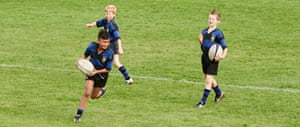 Having previously been taught the basics of catch, pass and run, children between eight through to 10 are introduced to tackling, and then uncontested scrums and line-outs. Photograph: Scott McAulay for the Guardian
Having previously been taught the basics of catch, pass and run, children between eight through to 10 are introduced to tackling, and then uncontested scrums and line-outs. Photograph: Scott McAulay for the Guardian
A lot of New Zealanders see Auckland as many English people do London, a city apart. After a week, it was time to head south, to Wellington and, specifically, the headquarters of the NZRU. I’m here to meet Brent “Buck” Anderson, general manager of community and provincial rugby. Six feet five and 260lb. He was a good player and won a single Test cap for the All Blacks in 1986. He has been part of the NZRU’s management team since 2001.
Meeting Anderson, I’m reminded of something John Daniell wrote. “François Truffaut once said that the French all thought they had two jobs: their own and film critic. In New Zealand people have their own job and an All Black managerial role.” Anderson has a thick skin and a phlegmatic temper. It’s useful, because it seems everyone in New Zealand has a view on what his department does and exactly how well it does it. “There’s four million New Zealanders,” he says, “who have all got a view about what’s right and what’s wrong.”
In New Zealand, organised rugby starts at the age of five. Or it is supposed to. As Anderson says: “I’m not as green as I am cabbage-looking. I know a lot of those kids will only be four or even three.”
Just like Bryan Williams’s grandchild. At that age they play a game called rippa rugby, seven-a-side and tackles are made by tearing tags off your opponent’s shorts. “It really is just about catch, pass and run.” Anderson thinks rippa rugby is one of the best things the NZRU has done. It is a simple, safe version of the game, easy to organise even if you know nothing about the sport.
From the ages of eight through to 10 children are introduced to tackling, and then uncontested scrums and lineouts. The teams expand to 10-a-side. Around the age of 11, they bring in 15-a-side and start contesting scrums and lineouts. At this point, the secondary schools take over so clubs lose their young players. The good thing about this is that kids are not playing too much. In the UK, a boy might play for his school one day and his club the next.
As Graham Henry says: “A young guy who is at the top of his game might play 20 games in a year, 25 at a stretch. Whereas when I was in Wales there were boys there playing 80, 90 games a year.”
When I was in Wales there were boys there playing 80, 90 games a year.
Running parallel to the secondary schools is the representative setup. The best players get called up to play age-group rugby for their provinces. “Some provinces will have under-13 teams,” Anderson says. “But we would question the need for that. Your chances of identifying talent at under-13 are pretty remote.” Then there are the academies. These used to start their talent spotting after kids had finished school. But “that identification is happening in first XV rugby now”, Anderson says. “And it’s not just the provincial unions, the Super Rugby franchises are starting to get involved, too, because they don’t want to have another franchise move in and grab the player.”
A talented 18-year old will be pulled in several different directions, by his school, his provincial union, his old club, and his local Super Rugby franchise. There is a tension here. But, interestingly, the NZRU seems less concerned about the kids who do make it than the ones who don’t. A lot of what the NZRU does at this level is about “keeping as many kids as possible in the system, playing the game, moving on with it through the age groups”. They have a small player base in New Zealand and are determined to maximise it.
The idea is that the longer you keep a child playing the game, the better the odds they develop into a top player. And for the many more who don’t make it, they at least develop a love of the game, which means “they watch it on TV, they buy Sky subscriptions, they join their provincial union, and more importantly than all, in a generation’s time they take their kids to play rugby”.
Three measures stand out. The first is weight gradings. In urban areas where there is a large playing base, children often have the choice of playing in teams that are organised by size rather than age.
A teenager could play for the under-15 team, or he could play for the under 55kg team. Weight-graded rugby is the fastest-growing form of the game in New Zealand today. Especially among adults. Some clubs now offer an under 80kg grade.
I’m 6ft 2in and about 80kg.
Teenagers
age 13 to 20 years
Small Blacks
age 5 to 12 years
Play rugby in New Zealand
150,564 people (3.4% of the population)
Anderson looks me up and down. “If you have to play an adult comp, you are going to end up playing with someone my size. And I’m 6ft 5in and 120kg. Or you could play on a team where everyone is about your shape and size.” I watch him size me up. And think the latter sounds pretty appealing. The second measure is more controversial. It’s called the half-time rule. In all youth matches, whenever one team is winning by 30 points or more at half-time, the two coaches are obliged to meet to discuss what they can do to even the game up. The winning side might decide to take off their best player or move him to another position.
The third measure is the least popular. At every level below school first XV, coaches are obliged to give every player in their match-day squad at least a half of rugby. “We get emails saying: ‘This is a bloody nonsense,’ ‘Political correctness gone mad,’ and all of that,” Anderson admits. “But we also get emails from parents saying: ‘Thank you, my kid was about to leave because he wasn’t getting any game time.’”
These innovations are unpopular with coaches but are being driven by the children. “Our customers are mainly teenagers and kids. We have got 28,000 adults playing the game, we’ve got 44,000 teenagers, and 80,000 under-13s,” Anderson says. “The risk is that we make too many decisions based on a coach’s view of their world.”
They spend a lot of time and effort surveying young players. In one of its recent surveys, the NZRU asked the participants to define what rugby meant to them. “For the coaches and the parents and the school administrators, it was about results, it was about winning, and it was about being better than everyone else,” Anderson says. “For the kids it was slightly different, for them it was about the battle and about a sense of ownership. About it being ‘my space, my game, my friends, my school’. And most of all it was about it being enjoyment.”
Christchurch boys’ high school has produced 12 new All Blacks within the last 15 years. Christchurch boys’ high school has produced 12 new All Blacks within the last 15 years. Photograph: CBHS
‘It’s in the psyche’
That night, a flight to Christchurch, a city still rebuilding after the 2011 earthquake. The local Super Rugby franchise, the Crusaders, is the most successful in the competition’s history. And while Auckland grammar may have produced the most All Blacks, Christchurch boys’ high is only a little way behind. It has had 45 altogether and 12 won their first caps in the last 15 years. Whatever the school is doing, it is working.
CBHS is a state school too but doesn’t feel like it. The buildings here are more austere than those at Auckland grammar but the school itself seems a little more relaxed. When I arrive around 200 kids are out on the playing fields in front of the school, some hitting tackles bags, some sprinting and passing, some working lineout drills. I stroll over to the main playing field, with its own little grandstand. The first XV squad are just wrapping up a training session. One of their coaches is an Englishman, Danny Port. He moved out two years ago. He had been working at Ivybridge community college in Devon, which is an academy for the Exeter Chiefs, and so one of the best rugby schools in the UK. “The differences between the two are quite stark,” he says. “The biggest is the number of kids who want to play, and how passionate they are about it.” When Port was there, Ivybridge and CBHS had roughly the same number of boys. Ivybridge ran seven rugby teams; at CBHS they run 22.
“If I said: ‘Right, we’re going to have a game at lunchtime, we need 30 boys,’ we’d get it done in 30 seconds,” Port says. “There would be volunteers coming from everywhere.” When Port first arrived, he coached what was in effect the school’s sixth team. “And I would still get 20, 25 players turn up, train twice a week, and play hard at the weekend.” And they can all catch, pass and kick a rugby ball. “That’s the difference. In the UK we often find a big kid and turn them into a rugby player. Whereas here everyone plays.
It’s in the psyche.”
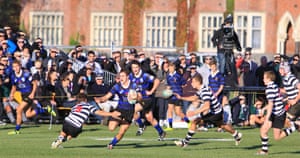
That night, a flight to Christchurch, a city still rebuilding after the 2011 earthquake. The local Super Rugby franchise, the Crusaders, is the most successful in the competition’s history. And while Auckland grammar may have produced the most All Blacks, Christchurch boys’ high is only a little way behind. It has had 45 altogether and 12 won their first caps in the last 15 years. Whatever the school is doing, it is working.
CBHS is a state school too but doesn’t feel like it. The buildings here are more austere than those at Auckland grammar but the school itself seems a little more relaxed. When I arrive around 200 kids are out on the playing fields in front of the school, some hitting tackles bags, some sprinting and passing, some working lineout drills. I stroll over to the main playing field, with its own little grandstand. The first XV squad are just wrapping up a training session. One of their coaches is an Englishman, Danny Port. He moved out two years ago. He had been working at Ivybridge community college in Devon, which is an academy for the Exeter Chiefs, and so one of the best rugby schools in the UK. “The differences between the two are quite stark,” he says. “The biggest is the number of kids who want to play, and how passionate they are about it.” When Port was there, Ivybridge and CBHS had roughly the same number of boys. Ivybridge ran seven rugby teams; at CBHS they run 22.
“If I said: ‘Right, we’re going to have a game at lunchtime, we need 30 boys,’ we’d get it done in 30 seconds,” Port says. “There would be volunteers coming from everywhere.” When Port first arrived, he coached what was in effect the school’s sixth team. “And I would still get 20, 25 players turn up, train twice a week, and play hard at the weekend.” And they can all catch, pass and kick a rugby ball. “That’s the difference. In the UK we often find a big kid and turn them into a rugby player. Whereas here everyone plays. It’s in the psyche.”
There is a stat about CBHS that the NZRU likes to cite. Almost half of CBHS’s first XV players did not make the A team when they started at the school. Port says that those boys “have had to fight for everything they’ve got, but they’ve matured later, and they’re not burned out and they’re not over-coached”. Owen Franks is a good example. When he was a student here, Franks was tiny and told he was too small for the first XV. He started bringing his own cool box into school and the first thing everyone remembers about him is how much time he spent eating. Franks has since won 69 caps for the All Blacks. As a prop.
I ask Port whether his boys take ice baths after matches. He laughs. There’s a basic sort of gym, open two mornings each week. That’s pretty much it. “Our resources are our kids,” he says, “hundreds and hundreds of tough kids.” The boys in the first XV at CBHS do not tend to be as big as some of those playing up in Auckland. But, as Port says, they are tough. CBHS’s headmaster, Nic Hill, says that’s just the way they raise them. “Take the earthquake, if it had happened in another province would they be doing as well as we are now? If it had to hit anywhere it was good that it was here, because here there is that toughness, that resilience, and we see that in our sport.”
Later that day I drive down to Southbridge, the hometown of CBHS’s most famous old boy, Dan Carter. I want to take a look at the land, get a sense of what it is about the place that gives boys “that toughness, that resilience”. Southbridge is only an hour or so away across the Canterbury Plains. But I make the mistake of following a satnav. It leads me down deserted dirt tracks, through fields that stretch as far as the eye can see in all directions.
Advertisement
The rain returns and I pass a couple of lorries loaded with rocks and rubble. Their wheels spray gravel and mud as they pass. By the time I arrive, the hire car is a wreck.
There’s a rooster in the road out in front of the Carter family’s house. After the storm, nothing else is moving much. Perhaps a curtain or two. You can spot the house by the goalposts in the garden. They were built by Carter’s father, so his boy could practise his kicking all hours. I knock but there’s no one in. The rugby club is a couple of fields over. It’s deserted. I stop at the garage to ask for better directions.
The owner says there is a steady trickle of tourists who come to see the Carters’ house. Dan’s parents once came home and found a Japanese family having a picnic on their lawn, underneath the goalposts.
There’s nothing much else in Southbridge. A bottle shop, a butcher, a bowls club, a couple of cafes. For the last few days I’ve been reading a play, Foreskin’s Lament. It was written by Greg McGee, who was a Junior All Black. John Daniell gave me his copy and it’s brilliant, all about a small-town rugby club in the 1980s. And I’m reminded of a line in it now. “The town is the team,” says the old coach. “It’s the town’s honour at stake when the team plays. God knows there’s not much else around here.”
‘Remember where you came from’
That night, I watch a new documentary, The Ground We Won. It’s about a season in the life of a country rugby club in Reporoa. A great film, beautifully shot. I drop the director an email. His name is Christopher Pryor. “We set out to explore the lives and exploits of a rural rugby team,” Pryor says, “to see why the game was so deeply important not only to the men involved, but by extension our culture at large.” Pryor and his team spent a year in Reporoa. “We found that there is a sense of community in rural places that is hard to replicate in the city,” Pryor says. “The local rugby club sitting at the heart of it all.” The Ground We Won reminds me of something Bryan Williams said: “You can’t begin to understand New Zealand rugby without getting out into the country.”
After the Carters, I decide to try phoning before making my next house call. Kevin Barrett answers, which is a start.
“You want to talk to me?” A pause.
“OK.”The Ground We Won: a clip from the documentary.
Barrett was a good rugby player, no better. He spent 13 years playing for his province, Taranaki, then played two seasons for the Hurricanes after the game turned professional. He is also father to five boys. His eldest, Kane, is a flanker, and plays for the Auckland Blues.
Or did do. He has been out for a long time now, suffering with concussion. Next is Beauden, 24, and already with 30 caps for the All Blacks. Then Scott, a lock who recently signed with the Crusaders. And finally Blake and Jordie, both too young to turn pro but dreaming of doing so.
Barrett lives outside Rahotu, an hour’s drive south of the town of New Plymouth. Another early flight. Another hire car. Another line from Foreskin’s Lament: “This is the heart and bowels of the country, too strong and foul and vital for reduction to bouquets, or oils, or words.”
Rahotu makes Southbridge feel busy. Nearby is the rocky outcrop of Cape Egmont and its lighthouse, the most westerly point in New Zealand. Barrett is working at the end of his drive, waiting for me. His handshake makes me wince but his smile makes me welcome. He runs a dairy farm, which he inherited from his father.
“We were born and bred here, you see.” He started working here as soon as he left school, when he was 16. He was already playing the club game. “The coast is all rugby,” he says. “It’s what we do.
“When I first played for Taranaki in ’86, we played for the love of it. And most of us, if not all of us, were farmers. So we would get up at 4.30 in the morning to milk the cows, do a day’s work, and then go training. Same on game day.”
In their pomp, Barrett’s Taranaki team were drawing crowds of 20,000 in a community of a little more than 100,000. “I was never going to be an All Black but I didn’t care. I was playing for fun in front of 20,000 people. It was awesome.”
Taranaki’s Kevin Barrett playing against Counties Manukau in the NPC first division.
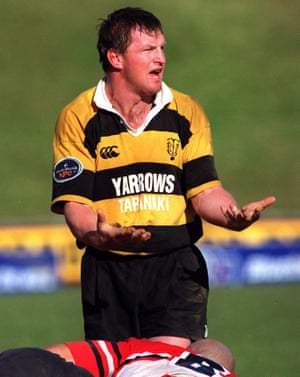 Taranaki’s Kevin Barrett playing against Counties Manukau in the NPC first division. Photograph: Ross Setford/Getty Images
Taranaki’s Kevin Barrett playing against Counties Manukau in the NPC first division. Photograph: Ross Setford/Getty Images
It was around that time the dairy factories started to shut down. Once that happened, the community shrank and the rugby clubs suffered. Barrett was instrumental in persuading three rival clubs, Opunake, Okato, and Rahotu, to amalgamate into one new one, Coastal. “It was pretty tough at the start because everyone was so entrenched in their own traditions, but we could see the benefit for our kids. And here we are now, 20 years later.” Coastal won their first championship three years ago.
Out back of Barrett’s house is the land they call the BCG: the Barrett Cricket Ground. This was where his kids would play every day with each other and the neighbours. “The kids were brought up on the back lawn. It was where our boys grew up. I’ve five boys and three daughters. The neighbour has two children. Across the road they got two boys and a daughter. They would all come here and play Test matches together out back.”
Barrett coached them a little. He taught them what he considers the “basic skills”, to “kick both feet, pass both ways, to be able to read the game”. In England, typically only a gifted back would be able to do all that. But Barrett’s thinking is that every player should have that same set of skills. Position is just a matter of size and besides, a prop should be able to put a winger away with a good pass just as much as a fly-half should.
When the boys grew older, their father had one more important lesson for them. “This is what I said to them: ‘Rugby is special, you put a jersey on and play for your province, or get picked for your country and pull on the All Black jersey, that’s a huge honour. But always remember who you are and where you came from, and always keep your feet on the ground. Because the day you take your jersey off you’re just one of us.’”
‘Tighten the ropes’
Homeward bound now, back to Auckland for the flight out. But first a diversion, to Rotorua in the Bay of Plenty, to meet Tiki Edwards. He is the NZRU’s Maori community manager. Around a quarter of New Zealand’s registered playing population are Maori. They have been playing the game just as long as the European settlers and their descendants, the Pakeha. The very first New Zealand team to tour Britain, in 1888-89, was described as a “native” side. This team were the first to perform the haka and the first, too, to wear the black jersey.
I drive all night, through a storm. It seems New Zealand has more types of rain than are known even to the English.
Tiki is also a force of nature, a great, garrulous man, only ever a breath away from a gust of laughter. We agree to meet in Rotorua airport. “You’ll know me when you see me, bro.” And so I do.
He blows in like the wind and sweeps me off in his car. We drive out to the town of Kawerau, to visit Tarawera high school. He talks even faster than he drives.
Kawerau district is beautiful country but hard land to grow up in. The town was built around a paper mill. In 2012 half the jobs were lost and the population has been in steep decline since. Around the same time, the town endured 13 suicides in the space of 18 months, most of them Maori men aged between 16 and 21. Tiki talks about “the Ps”: “Prison. Piss. Pot. Punch-ups. Parents. Peers. Pies. And P.” “P” is the nickname for methamphetamine. “All the things that can muck a kid up.”

\ Sonny Bill Williams on a visit to Tarawera high school. Facebook Twitter Pinterest
Sonny Bill Williams on a visit to Tarawera high school. Photograph: Courtesy of NZRU
Tarawera high is a good story. The school that used to be on the site was closed in 2012, and a new one opened. Ian Parata is the Bay of Plenty’s secondary school manager. “This used to be a school you wouldn’t have given two cents to play against,” he says. “It was ugly, man, they were just like thugs.”
Parata once came here with an under-14 team. They had to be escorted out of the changing rooms after the game. In 2014 Parata and his team returned for another match. “I briefed my boys. I said: ‘These guys are thugs, they play horrible rugby.’ And we got out there and it was one of the best and cleanest games I have ever seen played.”
Parata says: “Rugby here is about making a positive change in kids’ lives. Discipline, structure, fairness.” He and Tiki are organising a surprise school visit by the star All Black Sonny Bill Williams. They talk logistics with Tarawera’s rugby first XV coach, Antony Pritchard. Like Danny Port, he is an Englishman who moved to New Zealand. He remembers one of his first away games when the team had to catch an 8am bus. “Some of the kids turned up with boxes of deep fried chicken and chips for breakfast.” Another of his pupils was sleeping rough behind an electricity pylon because it was the warmest place he could find.
Pritchard says there are 10 or 11 boys in the school who are “great athletes, who would easily make my team”. But they don’t feel able to play because of other issues in their lives. Domestic abuse. Drug abuse. Gang culture. The Mongrel Mob and the Black Power gang both have a strong presence in the area. This means that Tiki needs a variety of different training bibs because the kids will refuse to wear them if they are in the colours of a rival gang.
At Tarawera high they don’t yet have a playing field, but rather a paddock without any markings. For the moment, all their games are away from home. The school has six tackle bags to go around. But there are a couple of good players here. Time was when they might have been spotted and recruited by a bigger school with better facilities. And that still may happen. But the administrators at Bay of Plenty want to make good players feel able to stay put, so they contribute to their rugby community.
“There are gold nuggets in every school,” Parata says. “We’ve got to try and get them out of the earth, and grab them and polish them and make them into gold coins.”
On the drive back to Rotorua, Tiki talks more about the ties between the people, their community, and their land. He mentions Maori concepts: whakapapa, ancestral connections; whenua, land connections; whanau, family connections. Tiki talks, too, about the haka. “People think it is a war challenge but to be honest mate, we never came to the battlefield to tell you that we were here to challenge you. We came to kill you. The haka isn’t about the enemy. It is about us. It’s about opening ourselves up to our ancestors, to their spirits, about filling ourselves with their strengths and gifts.” He pauses. “It is hard to explain. And to be honest, most Europeans don’t get it.”
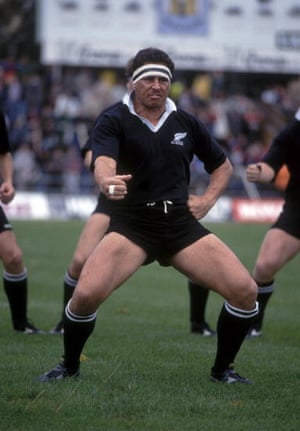
Wayne Shelford of New Zealand leads the haka before the All Blacks Tour match between Swansea and New Zealand held in 1989. New Zealand won the match 37-22. Photograph: Russell Cheyne/Getty Images
The All Black haka has not always been the spectacle that it is today; though it was always done, it was often done badly. It was only in the 1980s when two Maori players, Hika Reid and Buck Shelford, came to the fore that it began to be taken more seriously. They were men of mana, Tiki says, men other men follow.
Tiki tries explaining it in another way. “People talk about pressure. They say the All Blacks feel the weight of four million people, a weight that they have to carry. For Maori, it is the other way around. Those four million people have us on their shoulders. We don’t carry them, they carry us.” He sees the haka as an expression of that connection between the players and their people, their land, their ancestors. “It is real force for us. Someone like Dan Carter, he understands the thinking behind the Maori. But they can’t be full of it. It comes out of me, bro. It is who I am, bro.”
The All Blacks have folded a lot of this Maori thinking into their own philosophy. Tiki had just been working with the New Zealand Under-20 team. He taught them a new phrase: “Haumi e! Hui e! Tāiki e!” It means “tighten the ropes”, literally and metaphorically. They use it now as a team call. “Tighten the ropes” on this scrum, “tighten the ropes” on this defence.
“Originally that’s about tying each other to the canoe,” Tiki says. The Maori call their traditional boats waka. “When you are in the waka, in the middle of the ocean and the storm hits, tie yourself to the canoe. Then you are fully committed, bro, you can’t get out of the canoe in the storm.”
I say that it all feels a long way from Auckland grammar.
“We’re all tied to the same waka, bro,” Tiki replies, “and we’re all paddling in the same direction.”






















